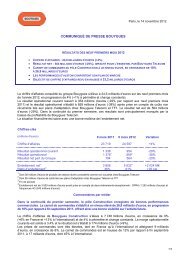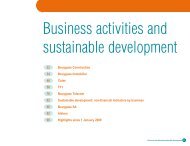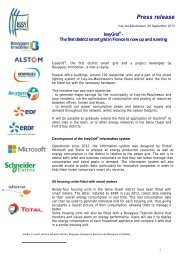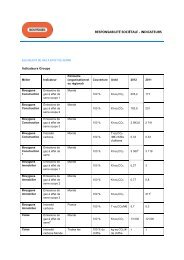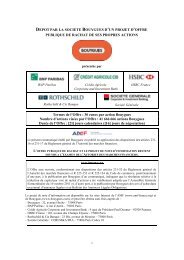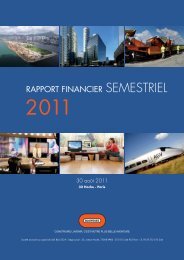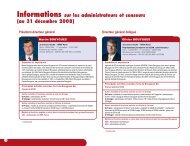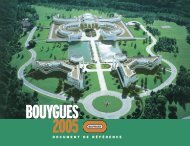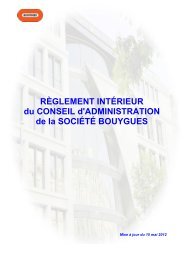Registration Document BOUYGUES
Registration Document BOUYGUES
Registration Document BOUYGUES
You also want an ePaper? Increase the reach of your titles
YUMPU automatically turns print PDFs into web optimized ePapers that Google loves.
4<br />
Legal and financial<br />
information<br />
Chairman's report<br />
17.4 Objectives/<br />
management cycle<br />
The purpose of introducing internal control procedures<br />
is to help the Group achieve its objectives<br />
by taking into consideration the risks to which it<br />
is exposed.<br />
The Group’s general objectives are defined through<br />
the management cycle, a process which enables<br />
the Group’s senior management to participate early<br />
on in determining the strategies of each business<br />
segment, to approve their business plans prepared<br />
in the context of that strategic framework, and then<br />
to monitor the gradual achievement of objectives<br />
in the course of the year.<br />
The principles of the management cycle are<br />
directly applicable in all Group entities, thus<br />
ensuring that the Group as a whole has a solid and<br />
coherent structure.<br />
This iterative process enables the Group’s senior<br />
management to ensure at all times that objectives<br />
are consistent with strategies, monitor any discrepancies<br />
between results and objectives, and<br />
anticipate remedial action to be taken at Group or<br />
business segment level (financing requirements,<br />
redefinition of priorities, etc.).<br />
Another aim is to provide the Group’s senior management<br />
and the Bouygues Board of Directors<br />
with all the information necessary for them to<br />
make decisions.<br />
The key members of the parent company’s senior<br />
management team sit on the Boards of the lead<br />
companies of the Group’s business segments, and<br />
it is those Boards that decide on strategic priorities<br />
and business plans.<br />
17.4.1 Strategic plan and business plan<br />
Each business segment defines its own strategic<br />
plan for the medium term (three years) taking into<br />
account the Group’s general strategy and its own<br />
particular characteristics. The strategic plan is presented<br />
to the Group’s senior management by the<br />
senior management of each business segment in<br />
May/June and to the Bouygues Board of Directors<br />
in December.<br />
The resulting action plans form the basis of the<br />
three-year business plans, and these are presented<br />
to the Group’s senior management by the<br />
senior management of each business segment in<br />
November and to the Bouygues Board of Directors<br />
in December.<br />
Business plans are adjusted in April to take<br />
account of the financial statements for the previous<br />
financial year and of any significant developments<br />
affecting the initial plan.<br />
17.4.2 Annual plan<br />
In the December business plan, the first year is<br />
described in the greatest detail and represents<br />
a commitment by each business segment to the<br />
Group’s senior management. This is known as the<br />
annual plan.<br />
An initial review of progress (or update) of the<br />
annual plan for the current year takes place in May/<br />
June, when the strategic plan is presented to the<br />
Group’s senior management.<br />
A second update takes place in November and is<br />
incorporated into the new business plan.<br />
17.5 Organisation –<br />
Key players<br />
Senior management<br />
Senior management teams are responsible for<br />
managing internal control arrangements as a<br />
whole, defining strategic priorities and ensuring<br />
that internal control and risk management procedures<br />
are designed and implemented in a manner<br />
appropriate to each company’s development.<br />
Accounts committees<br />
The characteristics and responsibilities of the<br />
Bouygues Accounts Committee are set out in the<br />
Corporate Governance section of this report. Each<br />
business segment’s Board of Directors has formed<br />
an Accounts Committee with similar responsibilities<br />
to those of the Bouygues Accounts Committee. In<br />
particular, these include monitoring the effectiveness<br />
of internal control and risk management<br />
systems. The business segments’ Accounts<br />
Committees review the programmes and findings<br />
of internal audits as well as the risk mapping exercises.<br />
Consequently, the Accounts Committee is<br />
a key component in the internal control and risk<br />
management mechanism.<br />
Internal control departments<br />
The parent company created a Group Internal<br />
Control and Audit department in 2010. The<br />
department will play a major role in developing<br />
the Group’s internal control policy. The Group<br />
Internal Control and Audit department is charged<br />
in particular with:<br />
> directing up the Group's internal control and<br />
audit functions;<br />
> coordinating the business segments' internal<br />
control, risk management and audit activities;<br />
The business segments are gradually putting in<br />
place an organisational structure dedicated to<br />
internal control. Generally, the bodies that are set<br />
up are mainly in charge of assessment campaigns<br />
and risk mapping. They sometimes take on more<br />
overarching responsibilities in relation to internal<br />
control procedures.<br />
The Bouygues Construction holding company<br />
directs internal control and receives support in<br />
rolling out the approach mainly from support sectors.<br />
Each entity has nominated an internal control<br />
correspondent, who serves as the operational<br />
contact point. This role is generally performed by<br />
the subsidiary’s Corporate Secretary.<br />
Bouygues Telecom has put in place a businesswide<br />
risk management process that is embedded<br />
in the company’s normal business cycle. A risk<br />
manager is responsible for the process, assisted<br />
by 22 risk correspondents who represent the<br />
organisation’s main departments and whose main<br />
task is to collate and assess risk. Risk correspondents<br />
and a validation group make sure that the<br />
overall system and its development are coherent.<br />
A report is submitted every four months to senior<br />
management. Furthermore, a presentation is made<br />
twice a year to the Accounts Committee and once<br />
a year to the Board of Directors.<br />
At TF1, the internal control approach is directed<br />
by the internal control manager, who reports<br />
to the Financial Control and Strategic Planning<br />
department. Risk Committees have been set up<br />
within operating entities, and each entity has a<br />
risk correspondent. There is also a Support Risk<br />
Committee, which deals with issues falling within<br />
the scope of support divisions.<br />
At Bouygues Immobilier, the Internal Control<br />
department is in charge of maintaining and<br />
<strong>BOUYGUES</strong> • 2011 <strong>Registration</strong> <strong>Document</strong> • LEGAL AND FINANCIAL INFORMATION • 185



